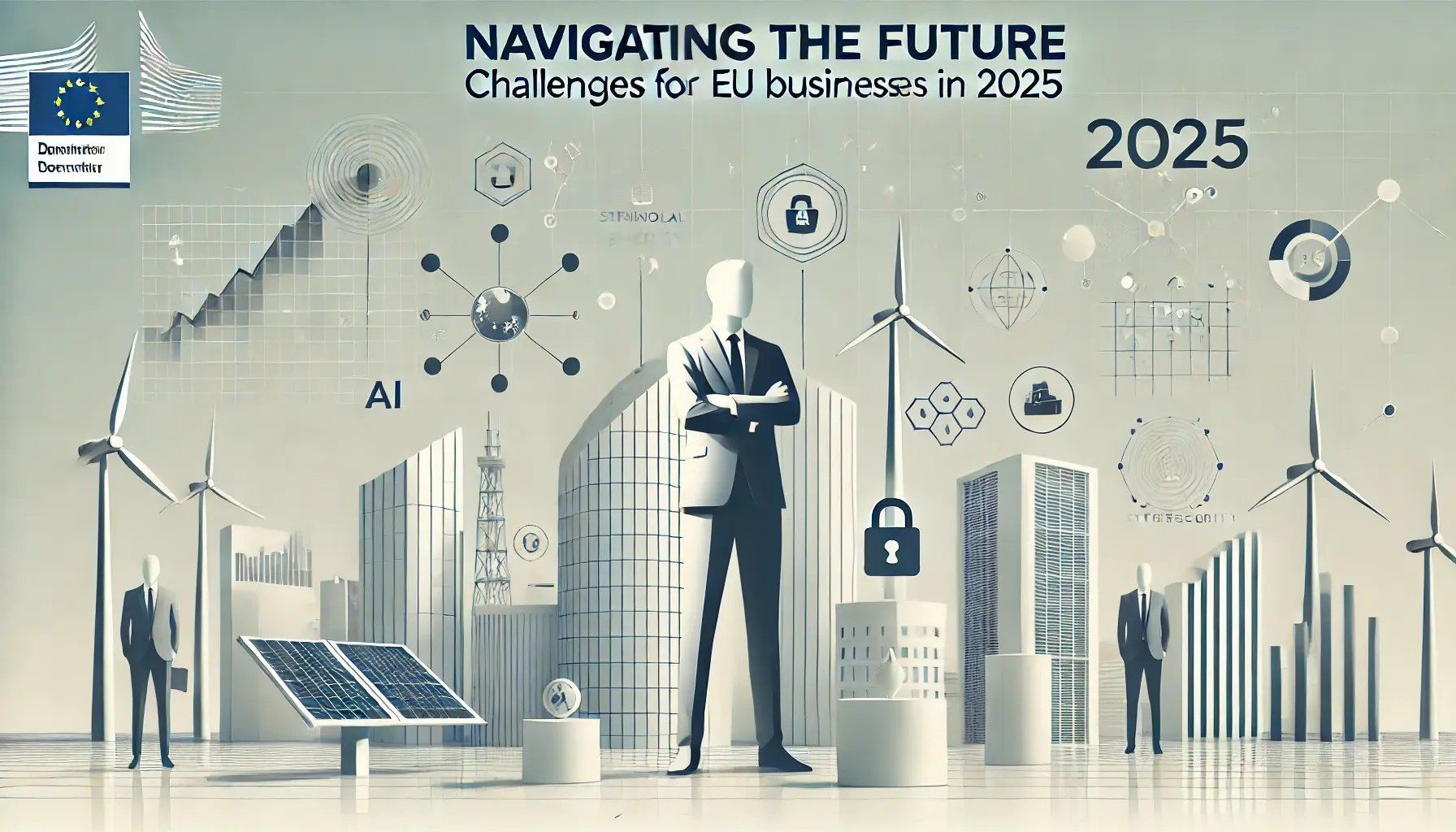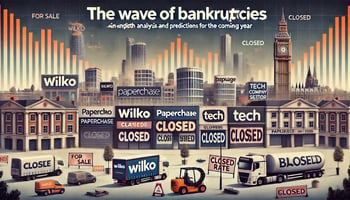What are the challenges facing the recruitment business face now? The recruitment business faces...
Navigating the Future: Challenges for EU Businesses in 2025
 The European Union (EU) has long been a hub of economic power and innovation, home to some of the world’s largest companies and most advanced economies. However, businesses across the EU face a rapidly evolving landscape shaped by global uncertainties, technological advancements, and shifting regulatory demands. Understanding these challenges is critical for organizations aiming to stay competitive and resilient in the years ahead.
The European Union (EU) has long been a hub of economic power and innovation, home to some of the world’s largest companies and most advanced economies. However, businesses across the EU face a rapidly evolving landscape shaped by global uncertainties, technological advancements, and shifting regulatory demands. Understanding these challenges is critical for organizations aiming to stay competitive and resilient in the years ahead.
1. Economic and Geopolitical Uncertainty
Supply Chain Vulnerabilities
The COVID-19 pandemic and geopolitical tensions, such as the war in Ukraine, have exposed significant weaknesses in global supply chains. The EU’s dependency on external markets, particularly for energy, semiconductors, and raw materials, exacerbates these vulnerabilities. According to the European Commission, the bloc imports 98% of its rare earth elements from China, a dependency that poses a strategic risk (European Commission, 2023). Efforts to diversify supply chains and promote “strategic autonomy” are underway but require substantial investment and time.
Inflation and Monetary Policy
Inflation remains a pressing concern for EU businesses. Eurostat reported an inflation rate of 5.3% in 2023, driven by rising energy costs and supply chain disruptions. The European Central Bank (ECB) has responded with interest rate hikes, making borrowing more expensive for businesses. This dual challenge of high costs and reduced access to capital is particularly acute for small and medium-sized enterprises (SMEs), which constitute 99% of all EU businesses (Eurostat, 2023).
Global Trade Dynamics
The EU’s trade relations are increasingly shaped by competition with the US and China. Initiatives like the US Inflation Reduction Act (IRA) have led to concerns over a potential subsidy race. The EU has responded with the Green Deal Industrial Plan, but navigating these complexities will require careful coordination among member states.
2. The Energy Transition and Sustainability Imperative
Regulatory Pressure
EU businesses are at the forefront of global sustainability efforts, driven by ambitious climate goals such as achieving carbon neutrality by 2050. The Corporate Sustainability Reporting Directive (CSRD), effective from 2024, requires detailed sustainability disclosures from over 50,000 companies, up from just 11,000 under previous rules (European Parliament, 2022). For many businesses, this represents a significant operational and financial challenge.
Energy Costs and Transition
Europe’s energy crisis, triggered by reduced gas supplies from Russia, has led to soaring costs. The transition to renewable energy sources, while necessary, demands significant upfront investment. A 2023 McKinsey report estimates that decarbonizing the EU’s industrial sector alone could require €1.5 trillion by 2050.
3. Workforce Dynamics and Demographic Shifts
Talent Shortages
The EU faces a growing skills gap, particularly in digital and green sectors. A 2022 report by the European Centre for the Development of Vocational Training found that 70% of EU companies struggled to find workers with the necessary skills. Countries like Germany, facing an aging population, are particularly vulnerable, with the working-age population projected to decline by 4 million by 2035 (Cedefop, 2022).
Remote Work and Changing Expectations
The pandemic has permanently altered workplace norms, with employees demanding greater flexibility. A 2023 Eurofound survey found that 37% of workers across the EU regularly worked from home, a trend that requires businesses to rethink productivity metrics and workplace culture.
4. Digital Transformation and Cybersecurity
Adopting Emerging Technologies
Digital transformation is both an opportunity and a necessity for EU businesses. Artificial Intelligence (AI), automation, and blockchain technologies promise to revolutionize industries, but adoption rates vary widely. According to Eurostat, only 8% of EU enterprises had adopted AI technologies by 2022, highlighting the scope for growth.
Cybersecurity Challenges
As businesses digitize, they become more vulnerable to cyber threats. A 2023 ENISA report noted a 20% increase in ransomware attacks across Europe, emphasizing the need for robust cybersecurity measures. Compliance with regulations like the EU Cybersecurity Act adds another layer of complexity.
5. Regulatory and Legal Complexity
Taxation and Labor Laws
The EU’s regulatory environment is becoming more complex, particularly around taxation and labor laws. The OECD’s Base Erosion and Profit Shifting (BEPS) framework, coupled with the EU’s own digital tax proposals, creates challenges for multinational corporations. Additionally, stricter labor laws, such as the Platform Work Directive, could increase costs for gig economy businesses.
Data Privacy and GDPR
The EU’s General Data Protection Regulation (GDPR) continues to influence global data privacy standards. While beneficial for consumers, GDPR compliance remains a costly and complex task for businesses, especially SMEs.
6. Climate and Environmental Risks
Physical Risks
Climate change poses direct risks to businesses, particularly in vulnerable regions like Southern Europe. Extreme weather events, from floods to wildfires, are becoming more frequent, disrupting supply chains and operations. According to the European Environment Agency, climate-related damages in Europe exceeded €12 billion annually over the past decade.
Transition Risks
Industries reliant on fossil fuels face increasing pressure to adapt or risk obsolescence. The EU’s Emissions Trading System (ETS), which sets a carbon price for industries, has seen allowance prices reach record highs, further incentivizing businesses to decarbonize.
7. Social and Cultural Shifts
Diversity and Inclusion
Consumers and employees increasingly expect businesses to prioritize diversity and inclusion (D&I). However, achieving meaningful progress remains a challenge. A 2023 Deloitte survey found that only 38% of European businesses had formal D&I strategies in place.
Changing Consumer Preferences
Sustainability is now a key purchasing criterion for EU consumers. Businesses must adapt by offering eco-friendly products and transparent supply chains. A 2023 survey by Statista revealed that 72% of EU consumers were willing to pay a premium for sustainable goods.
Conclusion
The challenges facing EU businesses are multifaceted, ranging from economic pressures and regulatory demands to workforce and technological shifts. However, these challenges also present opportunities for innovation and growth. Companies that embrace digital transformation, prioritize sustainability, and adapt to changing workforce dynamics will be better positioned to thrive in the evolving European landscape.
To navigate this complexity, businesses must engage in proactive planning, invest in technology, and foster a culture of resilience and adaptability. Policymakers, too, have a role to play in ensuring a supportive framework that balances ambition with practicality.
Sources
-
European Commission. (2023). "Strategic Dependencies and Capacities."
-
Eurostat. (2023). "SMEs in the European Union."
-
European Parliament. (2022). "Corporate Sustainability Reporting Directive (CSRD)."
-
McKinsey & Company. (2023). "Decarbonizing EU Industry: The Trillion-Euro Challenge."
-
Cedefop. (2022). "Skills and Labour Market Insights."
-
Eurofound. (2023). "Working Conditions in the European Union."
-
ENISA. (2023). "Threat Landscape Report."
-
European Environment Agency. (2023). "Climate Risks and Impacts in Europe."
-
Deloitte. (2023). "Diversity and Inclusion Strategies in Europe."
-
Statista. (2023). "Consumer Preferences for Sustainable Products in the EU."



